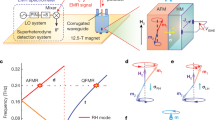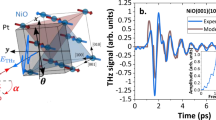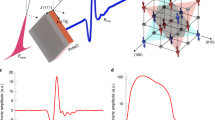Abstract
Magnonics is a research field complementary to spintronics, in which the quanta of spin waves (magnons) replace electrons as information carriers, promising lower dissipation1,2,3. The development of ultrafast, nanoscale magnonic logic circuits calls for new tools and materials to generate coherent spin waves with frequencies as high and wavelengths as short as possible4,5. Antiferromagnets can host spin waves at terahertz frequencies and are therefore seen as a future platform for the fastest and least dissipative transfer of information6,7,8,9,10,11. However, the generation of short-wavelength coherent propagating magnons in antiferromagnets has so far remained elusive. Here we report the efficient emission and detection of a nanometre-scale wavepacket of coherent propagating magnons in the antiferromagnetic oxide dysprosium orthoferrite using ultrashort pulses of light. The subwavelength confinement of the laser field due to large absorption creates a strongly non-uniform spin excitation profile, enabling the propagation of a broadband continuum of coherent terahertz spin waves. The wavepacket contains magnons with a shortest detected wavelength of 125 nm that propagate into the material with supersonic velocities of more than 13 km s–1. This source of coherent short-wavelength spin carriers opens up new prospects for terahertz antiferromagnetic magnonics and coherence-mediated logic devices at terahertz frequencies.
This is a preview of subscription content, access via your institution
Access options
Access Nature and 54 other Nature Portfolio journals
Get Nature+, our best-value online-access subscription
$29.99 / 30 days
cancel any time
Subscribe to this journal
Receive 12 print issues and online access
$209.00 per year
only $17.42 per issue
Buy this article
- Purchase on Springer Link
- Instant access to full article PDF
Prices may be subject to local taxes which are calculated during checkout




Similar content being viewed by others
Data availability
Source data for figures are publicly available at https://doi.org/10.5281/zenodo.4716539. All other data that support the findings of this paper are available from the corresponding authors upon request.
Code availability
The code used to simulate the magnon dynamics is available upon reasonable request.
References
Kruglyak, V. V. & Hicken, R. J. Magnonics: experiment to prove the concept. J. Magn. Magn. Mater. 306, 191–194 (2006).
Kruglyak, V. V., Demokritov, S. & Grundler, D. Magnonics. J. Phys. D 43, 264001 (2010).
Lenk, B., Ulrichs, H., Garbs, F. & Münzenberg, M. The building blocks of magnonics. Phys. Rep. 507, 107–136 (2011).
Chumak, A. V., Vasyuchka, V. I., Serga, A. A. & Hillebrands, B. Magnon spintronics. Nat. Phys. 11, 453–461 (2015).
Sander, D. et al. The 2017 magnetism roadmap. J. Phys. D 50, 363001 (2017).
Jungwirth, T., Marti, X., Wadley, P. & Wunderlich, J. Antiferromagnetic spintronics. Nat. Nanotechnol. 11, 231–241 (2016).
Němec, P., Fiebig, M., Kampfrath, T. & Kimel, A. V. Antiferromagnetic opto-spintronics. Nat. Phys. 14, 229–241 (2018).
Baltz, V. et al. Antiferromagnetic spintronics. Rev. Mod. Phys. 90, 015005 (2018).
Lebrun, R. et al. Tunable long-distance spin transport in a crystalline antiferromagnetic iron oxide. Nature 561, 222–225 (2018).
Li, J. et al. Spin current from sub-terahertz-generated antiferromagnetic magnons. Nature 578, 70–74 (2020).
Vaidya, P. et al. Subterahertz spin pumping from an insulating antiferromagnet. Science 368, 160–165 (2020).
Galkina, E. & Ivanov, B. Dynamic solitons in antiferromagnets. Low. Temp. Phys. 44, 618–633 (2018).
Giamarchi, T., Rüegg, C. & Tchernyshyov, O. Bose–Einstein condensation in magnetic insulators. Nat. Phys. 4, 198–204 (2008).
Johansen, Ø., Kamra, A., Ulloa, C., Brataas, A. & Duine, R. A. Magnon-mediated indirect exciton condensation through antiferromagnetic insulators. Phys. Rev. Lett. 123, 167203 (2019).
Bunkov, Y. M. et al. High-Tc spin superfluidity in antiferromagnets. Phys. Rev. Lett. 108, 177002 (2012).
Takei, S., Halperin, B. I., Yacoby, A. & Tserkovnyak, Y. Superfluid spin transport through antiferromagnetic insulators. Phys. Rev. B 90, 094408 (2014).
Qaiumzadeh, A., Skarsvåg, H., Holmqvist, C. & Brataas, A. Spin superfluidity in biaxial antiferromagnetic insulators. Phys. Rev. Lett. 118, 137201 (2017).
Dąbrowski, M. et al. Coherent transfer of spin angular momentum by evanescent spin waves within antiferromagnetic NiO. Phys. Rev. Lett. 124, 217201 (2020).
Kimel, A. et al. Ultrafast non-thermal control of magnetization by instantaneous photomagnetic pulses. Nature 435, 655–657 (2005).
Duong, N., Satoh, T. & Fiebig, M. Ultrafast manipulation of antiferromagnetism of NiO. Phys. Rev. Lett. 93, 117402 (2004).
Kampfrath, T. et al. Coherent terahertz control of antiferromagnetic spin waves. Nat. Photon. 5, 31–34 (2011).
Bossini, D. et al. Macrospin dynamics in antiferromagnets triggered by sub-20 femtosecond injection of nanomagnons. Nat. Commun. 7, 10645 (2016).
Afanasiev, D. et al. Ultrafast control of magnetic interactions via light-driven phonons. Nat. Mater. 20, 607–611 (2021).
Afanasiev, D. et al. Control of the ultrafast photoinduced magnetization across the Morin transition in DyFeO3. Phys. Rev. Lett. 116, 097401 (2016).
Usachev, P. et al. Optical properties of thulium orthoferrite TmFeO3. Phys. Solid State 47, 2292–2298 (2005).
Thomsen, C., Grahn, H. T., Maris, H. J. & Tauc, J. Surface generation and detection of phonons by picosecond light pulses. Phys. Rev. B 34, 4129–4138 (1986).
Hortensius, J. R., Afanasiev, D., Sasani, A., Bousquet, E. & Caviglia, A. D. Ultrafast strain engineering and coherent structural dynamics from resonantly driven optical phonons in LaAlO3. npj Quantum Mater. 5, 95 (2020).
Afanasiev, D., Zvezdin, A. & Kimel, A. Laser-induced shift of the Morin point in antiferromagnetic DyFeO3. Opt. Express 23, 23978–23984 (2015).
Balbashov, A., Volkov, A., Lebedev, S., Mukhin, A. & Prokhorov, A. High-frequency magnetic properties of dysprosium orthoferrite. Zh. Eksp. Teor. Fiz. [Sov. Phys. JETP] 88, 974–987 (1985).
Bar’yakhtar, V. G., Ivanov, B. & Chetkin, M. V. Dynamics of domain walls in weak ferromagnets. Sov. Phys. Usp. 28, 563–588 (1985).
Zvezdin, A. K. & Kotov, V. A. Modern Magnetooptics and Magnetooptical Materials (CRC Press, 1997).
Demokritov, S. O., Hillebrands, B. & Slavin, A. N. Brillouin light scattering studies of confined spin waves: linear and nonlinear confinement. Phys. Rep. 348, 441–489 (2001).
Qiu, H. et al. Ultrafast spin current generated from an antiferromagnet. Nat. Phys. 17, 388–394 (2021).
Razdolski, I. et al. Nanoscale interface confinement of ultrafast spin transfer torque driving non-uniform spin dynamics. Nat. Commun. 8, 15007 (2017).
Melnikov, A. et al. Ultrafast transport of laser-excited spin-polarized carriers in Au/Fe/MgO (001). Phys. Rev. Lett. 107, 076601 (2011).
Siddiqui, S. A. et al. Metallic antiferromagnets. J. Appl. Phys. 128, 040904 (2020).
Lebrun, R. et al. Long-distance spin-transport across the Morin phase transition up to room temperature in the ultra-low damping single crystals of the antiferromagnet α-Fe2O3. Nat. Commun. 11, 6332 (2020).
Hashimoto, Y. et al. All-optical observation and reconstruction of spin wave dispersion. Nat. Commun. 8, 15859 (2017).
Satoh, T. et al. Directional control of spin-wave emission by spatially shaped light. Nat. Photon. 6, 662–666 (2012).
Au, Y. et al. Direct excitation of propagating spin waves by focused ultrashort optical pulses. Phys. Rev. Lett. 110, 097201 (2013).
Bonetti, S. et al. Direct observation and imaging of a spin-wave soliton with p-like symmetry. Nat. Commun. 6, 8889 (2015).
Ozhogin, V. & Preobrazhenskiĭ, V. Anharmonicity of mixed modes and giant acoustic nonlinearity of antiferromagnetics. Sov. Phys. Usp. 31, 713–729 (1988).
Acknowledgements
We thank V. V. Kruglyak and R. Rejali for critically reading the manuscript and T. C. van Thiel and E. Demler for useful discussions. This work was supported by the EU through the European Research Council grant no. 677458 (AlterMateria), the Netherlands Organization for Scientific Research (NWO/OCW) as part of the Frontiers of Nanoscience programme (NanoFront), and the Veni, Vidi, Vici programme. R.V.M. and R.L. acknowledge support from the European Research Council grant no. 852050 (MAGSHAKE). R.C. acknowledges support by the project Quantox grant no. 731473, QuantERA-NET Cofund in Quantum Technologies, implemented within the EU-H2020 programme. B.A.I. acknowledges support from the National Scientific Foundation of Ukraine under grant no. 2020.02/0261.
Author information
Authors and Affiliations
Contributions
D.A. and A.D.C. conceived the project. J.R.H., D.A. and M.M. performed the experiments and analysed the data. B.A.I. developed the general theoretical framework describing the spin-wave propagation. R.L. and R.V.M. developed the theoretical formalism of the spin-wave detection. B.A.I., R.C., R.V.M. and A.V.K. contributed to discussion and theoretical interpretation of the results. A.D.C. supervised the project. The manuscript was written by J.R.H., D.A. and A.D.C., with feedback and input from all the co-authors.
Corresponding authors
Ethics declarations
Competing interests
The authors declare no competing interests.
Additional information
Peer review information Nature Physics thanks Xin Fan, Markus Münzenberg and the other, anonymous, reviewer(s) for their contribution to the peer review of this work.
Publisher’s note Springer Nature remains neutral with regard to jurisdictional claims in published maps and institutional affiliations.
Extended data
Extended Data Fig. 1 Experimental setup.
RR: gold retroreflector mounted on a motorized mechanical precision delay stage, OPA: optical parametric amplifier, BBO: β-barium borate crystal, WP: Wollaston Prism, D1, D2: a pair of balanced silicon photodetectors.
Extended Data Fig. 2 Time-resolved spin-wave detection at different temperatures.
a,b, Time resolved polarization rotation in the transmission (a) and reflection geometry (b) following excitation at hν = 3.1 eV for different temperatures. The probe incidence angle is near-normal, with λ0 = 700 nm.
Extended Data Fig. 3 Real part of the refractive index as a function of the pump photon energy.
Real part n of the refractive index, as extracted using spectroscopic ellipsometry measurements.
Extended Data Fig. 4 Simulations of the light-induced spin wave dynamics.
Real-space distribution of the magnon spin deflection at different times t, after optical excitation at hν = 3.1 eV with a penetration depth of 50 nm, as determined by equation (3).
Extended Data Fig. 5 Extracting the magnon propagation distance.
Time-resolved polarization rotation originating from a propagating magnon, as obtained in the reflection geometry. The solid line represents a best fit of a damped sine, giving a lifetime of about 85 ps. With the largest estimated group velocities vg of the measured magnons of about 13 km/s, this gives a propagation distance lc = vgτ = 1.1 μm.
Supplementary information
Supplementary Information
Supplementary Sections 1–5 and Figs. 1–8.
Source data
Source Data Fig. 1
Source data for Fig. 1.
Source Data Fig. 2
Source data for Fig. 2.
Source Data Fig. 3
Source data for Fig. 3.
Source Data Fig. 4
Source data for Fig. 4.
Rights and permissions
About this article
Cite this article
Hortensius, J.R., Afanasiev, D., Matthiesen, M. et al. Coherent spin-wave transport in an antiferromagnet. Nat. Phys. 17, 1001–1006 (2021). https://doi.org/10.1038/s41567-021-01290-4
Received:
Accepted:
Published:
Issue Date:
DOI: https://doi.org/10.1038/s41567-021-01290-4
This article is cited by
-
Reconfigurable spin current transmission and magnon–magnon coupling in hybrid ferrimagnetic insulators
Nature Communications (2024)
-
New type of magnetism splits from convention
Nature (2024)
-
Terahertz-field-driven magnon upconversion in an antiferromagnet
Nature Physics (2024)
-
Improvement of high-frequency magnetic properties of CoFeB thin film using oblique deposition for spin wave electronic devices
Journal of Materials Science: Materials in Electronics (2024)
-
Ultrafast push for counterintuitive spintronics
Nature Materials (2023)



